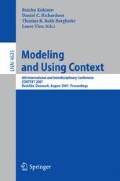Abstract
Mechanisms that underlie the inductive reasoning process in risk contexts are investigated. Experimental results indicate that people rate the same inductive reasoning argument differently according to the direction of risk aversion. In seeking to provide the most valid explanation of this, two kinds of models based on a Support Vector Machine (SVM) that process different knowledge spaces are proposed and compared. These knowledge spaces—a feature-based space and a category-based space—are both constructed from the soft clustering of the same corpus data. The simulation for the category-based model resulted in a slightly more successful replication of experimental findings for two kinds of risk conditions using two different estimated model parameters than the other simulation. Finally, the cognitive explanation by the category-based model based on a SVM for contextual inductive reasoning is discussed.
Access this chapter
Tax calculation will be finalised at checkout
Purchases are for personal use only
Preview
Unable to display preview. Download preview PDF.
References
Ashby, F.G., Maddox, W.T.: Relations between prototype, examplar, and decision bound models of categorization. Journal of Mathematical Psychology 37, 372–400 (1993)
Hampton, J.A.: Polymorphous concepts in semantic memory. Journal of Verbal Learning and Verbal Behavior 18, 441–461 (1979)
Heit, E., Rubinstein, J.: Similarity and property effects in inductive reasoning. Journal of Experimental Psychology: Learning, Memory, and Cognition 20, 411–422 (1994)
Hofmann, T.: Probabilistic latent semantic indexing. In: Proceedings of the 22nd International Conference on Research and Development in Information Retrieval:SIGIR 1999. pp. 50–57 (1999)
Kameya, Y., Sato, T.: Computation of probabilistic relationship between concepts and their attributes using a statistical analysis of Japanese corpora. In: Proceedings of Symposium on Large-scale Knowledge Resources: LKR 2005 (2005)
Kruschke, J.K.: ALCOVE: An exemplar-based connectionist model of category learning. Psychological Review 99, 22–44 (1992)
Kudoh, T., Matsumoto, Y.: Japanese Dependency Analysis using Cascaded Chunking. In: Proceedings of the 6th Conference on Natural Language Learning: CoNLL 2002, pp. 63–39 (2002)
Matsuka, T., Nickerson, J.V., Jian, J.: A prototype model that learns and generalize Medin, Alton, Edelson, & Frecko (1982) XOR category structure as humans do. In: Proceedings of the Twenty-Eighth Annual Conference of the Cognitive Science Society (2006)
Medin, D.L., AltonM., W., Edelson, S.M., Freko, D.: Correlated symptoms and simulated medical classification. Journal of Experimental Psychology: Learning, Memory, and Cognition 8, 37–50 (1982)
Nosofsky, R.M.: Attention, similarity, and the identification categorization relationship. Journal of Experimental Psychology: General 115, 39–57 (1986)
Osherson, D.N., Smith, E.E., Wilkie, O., Lopez, A., Shafir, E.: Category-Based Induction. Psychological Review 97(2), 185–200 (1990)
Pereira, F., Tishby, N., Lee, L.: Distributional clustering of English words. In: Proceedings of the 31st Meeting of the Association for Computational Linguistics, pp. 183–190 (1993)
Rips, L.J.: Inductive judgment about netural categories. Journal of Verbal Learning and Verbal Behavior 14, 665–681 (1975)
Rosch, E.: On the internal structure of perceptual and semantic categories. In: Moore, T.E. (ed.) Cognitive Development and the Acquisition of Language, pp. 111–144. Academic Press, New York (1973)
Sakamoto, K., Terai, A., Nakagawa, M.: Computational Models of Inductive Reasoning and Their Psychological Examination: Towards an Induction-Based Search-Engine. In: Proceedings of the Twenty-Seventh Annual Conference of the Cognitive Science Society, pp. 1907–1912 (2005)
Sakamoto, K., Nakagawa, M.: The Effects of negative premise on Inductive reasoning: A psychological experiment and computational modeling study. In: Proceedings of the Twenty-Eighth Annual Conference of the Cognitive Science Society, pp. 2081–2086 (2006)
Sakamoto, K., Terai, A., Nakagawa, M.: Computational Models of Inductive Reasoning Using the Statistical Analysis of a Japanese Corpus. The Journal of Cognitive Systems Research (in press, 2007)
Sanjana, N.E., Tenenbaum, J.B.: Bayesian models of inductive generalization. In: Becker, S., Thrun, S., Obermayer, K. (eds.) Advances in Neural Processing Systems 15, MIT press, Cambridge, MA (2003)
Sloman, A.T.: Feature-Based Induction. Cognitive Psychology 25, 231–280 (1993)
Smith, E.E., Shafir, E., Osherson, D.: Similarity, plausibility, and judgment of probability. Cognition 49, 67–96 (1993)
Vapnik, V.: The Nature of Statistical Learning Theory. Springer, Heidelberg (1995)
Author information
Authors and Affiliations
Editor information
Rights and permissions
Copyright information
© 2007 Springer-Verlag Berlin Heidelberg
About this paper
Cite this paper
Sakamoto, K., Nakagawa, M. (2007). Risk Context Effects in Inductive Reasoning: An Experimental and Computational Modeling Study. In: Kokinov, B., Richardson, D.C., Roth-Berghofer, T.R., Vieu, L. (eds) Modeling and Using Context. CONTEXT 2007. Lecture Notes in Computer Science(), vol 4635. Springer, Berlin, Heidelberg. https://doi.org/10.1007/978-3-540-74255-5_32
Download citation
DOI: https://doi.org/10.1007/978-3-540-74255-5_32
Publisher Name: Springer, Berlin, Heidelberg
Print ISBN: 978-3-540-74254-8
Online ISBN: 978-3-540-74255-5
eBook Packages: Computer ScienceComputer Science (R0)

